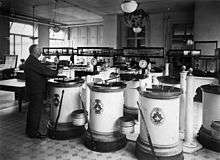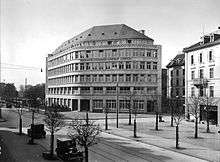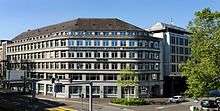Testex
Testex, stylized as TESTEX, is a globally operating, independent Swiss testing and certification organisation that focuses on textile testing. The Testex corporate group is headquartered in Zurich and consists of the Testex AG, ÖTI GmbH (Austria), PT Testex (Indonesia), Swiss Textile-Testing Ltd. Hong Kong, and Testex Testing Co. Ltd. Beijing. Testex AG emerged from the “Seidentrocknungsanstalt Zurich” founded in 1846, and operates more than 20 branches[1] worldwide. Testex is the official representative of the Oeko-Tex Association in Australia, Canada, the P.R. China, Hong Kong, Indonesia, Malaysia, New Zealand, the Philippines, Switzerland, South Korea and Taiwan.
 | |
| Industry | Textile testing, certification |
|---|---|
| Founded | September 22, 1846 in Zurich, Switzerland |
| Headquarters | Zurich, Switzerland |
Key people | Serge Rolle (CEO) |
Number of employees | >200 |
| Website | www |
Operations
Analytical Testing
The analytical laboratory at Testex is ISO 17025 certified[2] and conducts a variety of analytical tests designed to detect pollutants, residues, and trace elements in textiles. Testing and auditing are also conducted in accordance with the guidelines specified by the Oeko-Tex Association. These include Standard 100 by Oeko-Tex, Step, Made in green, Eco passport, Allergy Standards[3] and the Leather standard. The product portfolio is continually adapted according to the current market needs.
Physical and Chemical Textile Testing
Testex conducts physical and chemical tests on fibers, yarns/ strings, woven fabrics, knitted fabrics, nonwoven fabrics, and finished products. The services also include physiological tests on textile fabrics and ready-made textiles, flooring tests and the testing of personal protective equipment (PPE) in accordance with ISO 17065,[2][4] which involves various flaming tests.
History
The Silk Industry in Zurich
As early as 1237, raw silk was documented to be brought to Zurich from Como via Walenstadt. At that time, shipments were transported in primitive vehicles on poorly paved roads, narrow bridle paths, and dangerously labile, unstable footbridges.[5] Back then, transporting silk was much more laborious and hazardous than it is today. To reach Chur and adjacently Walenstadt, traders were forced to pass the Septimer Pass and the old imperial road. From there, the goods were transported to Zurich by boat. Upon arrival, the silk was unloaded near the Helmhaus Bridge and sold in a store near the Fraumünster.[5]
Silk Drying

In order to determine the curb weight of silk, it must be completely dry. However, this process is heavily influenced by the atmospheric humidity, since the material absorbs moisture from the air and thereby increases in weight[6] This property of raw silk makes it difficult to accurately determine its weight, which created the need for independent “weighing institutes”. These institutes were established to dry all traders’ silk according to a standardized method and thereby ensure a fair silk trade. Per definition, a silk conditioning institute is “a neutral authority whose test results are recognized as binding by both contractual parties."[7]
The first silk conditioning institute opened on April 8, 1724 in Turin.[7] It would remain the only institution of its kind until Jean-Louis Rast-Maupas opened a similar institution with improved procedures in Lyon in 1779. During the French Revolution, Rast-Maupas's “Condition” was closed for nearly two years. During this time, three similar institutes opened in Lyon, setting off a fierce competition. In 1805, Napoleon granted the Lyon Chamber of Commerce the exclusive right to dry silk, resulting in the establishment of a state institution in 1814.[8] Following the establishment of institutions in Turin, Lyon, and Milan, others quickly followed in Elberfeld, Krefeld, Saint-Étienne, Vienna, Zurich, and, finally, in New York, Yokohama, Kobe, Shanghai, and Guangzhou.[7]
Founding
The silk industry experienced a considerable boom around 1846. It became obvious that it would be disadvantageous to remain dependent on foreign silk conditioning institutions, a “provisional committee” decided to establish a silk drying institute in Zurich. On September 22, 1846, the constitutive assembly approved the statutes. Nearly 50 silk experts gathered in the “Zunfthaus zur Zimmerläuten” to elect a board of directors for the newly founded institute. Colonel Heinrich von Muralt-Stockar was elected Chairman of the Board,[9] and Lord Schwarzenbach-Imhof was appointed as director. Three days later the board met for the first time, and operations began on June 1, 1847. At that time, they did not yet have any practical experience in silk drying.[10]
Three individuals were primarily responsible for the founding of the Silk Drying Institute in Zurich. They became aware of silk drying while travelling abroad and wanted to establish the practice in Switzerland in order to make the local silk trade less dependent on foreign entities. All three were politically active and well known throughout the city.
Colonel Heinrich von Muralt-Stockar served as Chairman of the Board for 14 consecutive years, he was the son of Hans Conrad von Muralt, the former mayor of Zurich. At the age of 27, he took over his father's silk business “Heinrich de Daniel Muralt” and served as president of Zurich's “Baukollegium”, and the “Dampfschifffahrtsgesellschaft”.
Cavalry Captain Conrad Bürkli, a senior commander of the fire brigade, was a close friend of von Muralt's. He had been the proprietor of the Johann Georg Bürkli silk trading company since 1811, as well as a member of the city council.
Johann Heinrich (Henry) Bodmer-Pestalozzi was a member of the Bodmer zur Arch family and owner of the family's eponymous silk production company. The company was among the first in Switzerland to produce silk gauze.
Facilities

Between 1846 and 1863, the Silk Drying Institute resided in the “Äusseren Tiefenhof”, where the headquarters of the Zurich Cantonal Bank are located at present. The facility, located in the center of Zurich, covered roughly 5,525 square feet.[11] On October 1, 1849, a new branch was opened in Basel, which would later detach itself organizationally and financially from its parent company in 1872.[12] Due to the company's rapid growth and an acute need for additional space, a new facility was acquired in 1861: the “weissen Bären,” located on the corner of Bärengasse and Talstrasse. The company officially moved to the new facility in 1863, after two years of renovations and furnishing. The facility remained in use until 1932, when it was replaced by the company's present-day headquarters in Zurich's Enge district, which officially opened on April 14, 1932. Although an expansion of the company's operational space had been in discussion since as early as 1889, the implementation was delayed, due to World War I.[13]
The Zurich Silk Industry in Its Prime
In the second half of the 19th century, free trade policies and technological advances such as the telephone and the telegraph, introduced a period of prosperity for the silk trade. The Gotthard railway connection, completed in 1882, and the completion of the Suez Canal in 1869 made international trade significantly easier. On account of its constant improvements to the silk drying procedure and improved logistics and storage, Zurich became the center of the international silk trade.
The War and Post-War Eras
Zurich retained this status during World War I despite the difficult conditions, which caused interruptions and declines in sales. Many banks and other businesses closed following the outbreak of war. This resulted in a shortage of liquid funds, which soon impacted the silk trade. The home countries of the institutions in Milan, Turin, Lyon, Krefeld, and later Tokyo and New York, had entered the war. This favored the silk industry in Zurich tremendously, hence it achieved record sales between 1915 and 1917.[13]
World War II
While the transition from a peacetime economy to a wartime economy posed fewer issues in World War II than it did in World War I, the war years were even tougher for the silk trade. As a national economy, Switzerland was largely cut off from foreign markets. While the silk trade was exempt from rationing measures, it was subordinated to the Swiss Textile Syndicate along with all other branches of the textile industry. The export guarantee issued by the Swiss Federal Council eased the situation for exports only.[14] Starting in 1944, silk experienced a certain upswing due to the temporary shortage of wool and cotton. Following the war, the silk business began to flourish once again. Large supplies of Italian silk were exported to Switzerland, which stimulated the local economy.
Present
Decline of the Swiss Silk Industry

Following the development of synthetic fibers, particularly after World War II, the Swiss silk industry began processing less and less real silk.[15] As a result, the demand for traditional silk drying methods declined significantly. In 1970, the company responded to the shifting market conditions by focussing on textile testing and changing its name to Testex AG.[16] This laid the foundation for a new reorganization to a modern testing institute. In 1993, Testex joined the Oeko-Tex Association and began conducting human ecological tests on textiles.[17]
Testex Today
Today, little remains of the silk drying institute. The boom eras of Zurich's silk industry are a thing of the past, and the Swiss textile industry has long been in decline. The "Seidentrocknungsanstalt", however, has managed to avoid a similar fate. Today, Testex AG is one of the largest textile testing companies in the world, and has experienced significant growth since the turn of the century. At the end of 2006, Testex AG engaged 66 employees,[18] whereas in 2017 the company employs over 200 people in 20 locations worldwide.[19]
References
- "TESTEX - Who we are". www.testex.com. Retrieved 2017-08-14.
- SAS, Swiss Accreditation Service. "Search Accredited Bodies SAS". www.sas.admin.ch. Retrieved 2017-08-14.
- "Allergy Standards". allergystandards.com Allergy Standards Limited.
- "EUROPA - European Commission - Growth - Regulatory policy - NANDO". ec.europa.eu. Retrieved 2017-08-14.
- Jenny, Hans (1946). Hundert Jahre Seidentrocknungs-Anstalt Zürich, 1846–1946 (in German). Zurich: Orell Füssli AG. p. 4.
- Jenny, Hans (1946). Hundert Jahre Seidentrocknungs-Anstalt Zürich, 1846–1946 (in German). Zurich: Orell Füssli AG. p. 19.
- Jenny, Hans (1946). Hundert Jahre Seidentrocknungs-Anstalt Zürich, 1846–1946 (in German). Zurich: Orell Füssli AG. p. 24.
- Jenny, Hans (1946). Hundert Jahre Seidentrocknungs-Anstalt Zürich, 1846–1946 (in German). Zurich: Orell Füssli AG. p. 22.
- Jenny, Hans (1946). Hundert Jahre Seidentrocknungs-Anstalt Zürich, 1846–1946 (in German). Zurich: Orell Füssli. p. 28.
- Jenny, Hans (1946). Hundert Jahre Seidentrocknungs-Anstalt Zürich, 1846–1946. Zurich: Orell Füssli AG. p. 29.
- Jenny, Hans (1946). Hundert Jahre Seidentrocknungs-Anstalt Zürich, 1846–1946 (in German). Zurich: Orell Füssli AG. p. 31.
- Jenny, Hans (1946). Hundert Jahre Seidentrocknungs-Anstalt Zürich, 1846–1946 (in German). Zurich: Orell Füssli AG. p. 33.
- Jenny, Hans (1946). Hundert Jahre Seidentrocknungs-Anstalt Zürich, 1846–1946 (in German). Zurich: Orell Füssli AG. p. 77.
- Jenny, Hans (1946). Hundert Jahre Seidentrocknungs-Anstalt Zürich, 1846–1946 (in German). Zurich: Orell Füssli AG. p. 65.
- AHB, Liliane Mottu-Weber /. "Seide". HLS-DHS-DSS.CH (in German). Retrieved 2017-08-14.
- "Le Fil Rouge, Jubiläumsausgabe zum 160-jährigen Bestehen der ehemaligen Seidentrocknungsanstalt Zürich". www.testex.com (in German). Retrieved 2017-08-14.
- "Milestones TESTEX AG". www.testex.com (in German). Retrieved 2017-08-14.
- "Von der "Sidetröckni" zum Hightech-Betrieb - das Textilprüfinstitut Testex: Ist der Teddybär resistent gegen Speichel?". Neue Zürcher Zeitung (in German). 2006-12-29. ISSN 0376-6829. Retrieved 2017-08-14.
- "TESTEX - Gruppe". www.testex.com. Retrieved 2017-08-14.
Bibliography
- Hans Jenny, Hundert Jahre Seidentrocknungs-Anstalt Zürich. 1846–1946, Zürich: Orell Füssli AG 1946 (German)
External links
- Official website (in English)